 |
 |
| Home | Welcome | What's New | Site Map | Glossary | Weather Doctor Amazon Store | Book Store | Accolades | Email Us |
 | |||||||||||||||||||
Weather Almanac for March 2000THE DAYS NIAGARA FALLS
|
|||||||||||||||||||
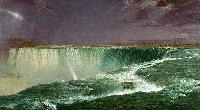 |
Although Niagara Falls does not have a major influence on the weather away from the Niagara River Gorge, there is always much for the avid sky and weather watcher to see at the Falls. Given a bright sun at just the right angle, it is almost impossible to not see a rainbow forming in the mist of billions of gallons of water plunging over the Falls. And if you happen to find yourself downwind of the Falls, be prepared to get wet -- rain-proof clothing is well advise -- as the Falls' mist passes over you. It can be as drenching as a summer thunderstorm and, in the colder seasons, quickly chill you to the bone.
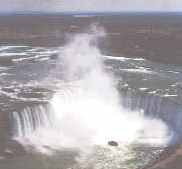 | 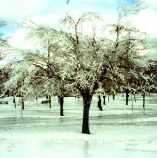 |
Beautiful and awe-inspiring as Niagara Falls is during the warm season, it takes an even more splendid appearance in the colder months. It does so in several ways. First, the liquid mist, when near-freezing in temperature, will quickly freeze when it contacts nearby cold objects. When the ice freezes, it forms a white, opaque ice -- known as rime -- on trees and bushes. The beautiful scene sparkles in the sunlight, a sight that must be seen to be imagined.
Even in the coldest months, the river waters continue to flow, carrying Lake Erie and Niagara River ice over the cataract and into the great basin below the Falls. Some of these blocks of ice are quite large and able to temporarily withstand the erosive forces of the raging waters. When the temperatures are right, some of the falling water freezes instantly on the block ice and form great ice falls in front of the actual waterfalls. Such formations grow further forming castle turrets and other outcrop patterns as the mist settles on them. On occasion, a ice bridge forms across the Niagara River within the Great Gorge below the Falls as a result of the laying down of these ice blocks.
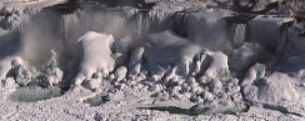 |
On six reported occasions (1883, 1896, 1904, 1909, 1936 and 1947), the water flow over American Falls has been totally blocked by ice and ceased to fall. But only once has this happened to the much larger Horseshoe Falls (originally known as the Canadian Falls): March 29-31, 1848, the Days Niagara Falls Went Dry.
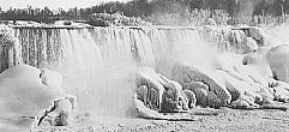 |
There appears to have been nothing terribly unusual about the winter of 1847-48 nor the onset of spring in March. Nor was there any evidence that the ice on Lake Erie was unusually thick. But during the night of March 29-30, 1848, the great cataracts over both falls diminished, slowed to a trickle and then stopped completely! When the local residents awoke on the morning of the 30th, something felt wrong...indeed, something sounded wrong. There was...silence. No roaring water filled the ambient background as it had every morning in anyone's memory.
Many rushed to the Falls and saw: rock and ice and some ponds and pools of water. The Niagara River had stopped flowing, and both the Horseshoe Falls and the American Falls had stopped, well, falling! Soon too, the Welland River which receives its waters upstream of the Falls was reduced to a freshlet and the water wheels at factories and flour mills ground to a halt.
Despite the limited and slow communication network of the day, a reported 5000 people from as far as Hamilton, Ontario and Buffalo, New York converged on the scene, jamming local roads. Thousands attended special church services, convinced that the incident was a prophetic sign of greater disasters yet to come.
But many brave souls took the opportunity to descend into the Great Niagara Gorge and explore the never-before-seen basin at the foot of the Niagara Falls. Some retrieved a variety of relics from beneath the Falls, including weapons from the War of 1812: bayonets, musket barrels, swords, pistols and tomahawks. Several enterprising men brought a cart to the edge of the Horseshoe Falls and salvaged huge pine logs and timbers 12-18 metres (36-60 ft) long that had jammed there. These were eventually turned into furniture and sold (at premium price?) as special items that had an incredible and rare story attached to their wood.
Others used the opportunity to walk or ride across the river above and below the Falls. A squadron of United States Army calvary rode down the river bed enjoying the novel situation. Operators of the Maid of the Mist excursion boat took the occasion to blast away a rock outcrop from the channel which had threatened the boat's keel.
The eerie event (after all, the water normally plunging over the Falls comes from Lake Erie) was so overpowering in magnitude that decades later, eye-witnesses to the event were asked to sign declarations swearing to their presence there.
The cause of the water stoppage appears to have been a perfect ice dam formed at the source of the Niagara River near Buffalo. Normally in late March, ice which has covered Lake Erie during the winter begins to break-up, and the larger chunks are pushed by the wind and currents toward the eastern end of the Lake. There they can pile up in ridges and rafted ice, but usually, such a wall of ice does not reach to the river bed and is too porous to do more than slow the water flow into the river.
But this was not the case in late March of 1848. From observations at the time, here is what likely happened.
A strong but slow-moving storm system passing through Lake Erie basin was the most logical suspect in the water flow stoppage. Weather reports indicated that for several days prior to March 29, strong easterly winds drove ice blocks and pack ice back into the open lake waters. Then on the 29th, the winds suddenly reversed direction, coming strongly from the west and southwest, and drove the lake ice rapidly toward the neck of Lake Erie and the Niagara River entrance, somewhere between Fort Erie and Buffalo. The combined force of wind, current and waves jammed the ice blocks together in such a manner that a completely impenetrable ice dam was formed. Thus, waters no longer flowed through the Niagara River toward Lake Ontario and the Niagara Falls.
The shift in wind also brought very warm air temperatures which rose to 16 C (61 F) on the 31st. The combination of warm air and pounding winds and waters eventually broached the ice dam, and flow into the Niagara River was again restored, some 30 hours after it had ceased. During the night hours of March 31, a "low growl" began upstream of the Falls and then suddenly a wall of water rushed down the riverbed and leapt over the Falls. Local residents returned to their beds, relieved and again comforted by the assuring roar of waters over the great Niagara Falls.
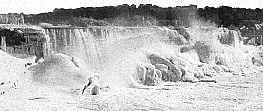 |
To date, this was the only natural occasion when the waters of the full Niagara Falls complex stopped completely. An ice boom placed in Lake Erie to protect water intakes for the hydroelectric generating stations on both sides of the Niagara River will likely prevent a similar ice dam from ever again forming.
As mentioned, the American Falls has fallen silent on six other occasions. I emphasized the word natural because in 1969 for seven months, the US Army Corps of Engineers diverted the river and shut off Niagara Falls so that repairs to be made to the American Falls rock face which was eroding rapidly.
But if you happen to stroll by the Falls between midnight and dawn, you might notice that less water is falling into the gorge. During these hours, more water is diverted from the river into the water intakes of the power-generator turbines. By dawn, however, the water flow is again restored so that no honeymooner or tourist will miss the grandeur and beauty of Niagara Falls.
 |
To Purchase Notecard, |
Now Available! Order Today! | |
 |
 |
NEW! Now |
The BC Weather Book: |


